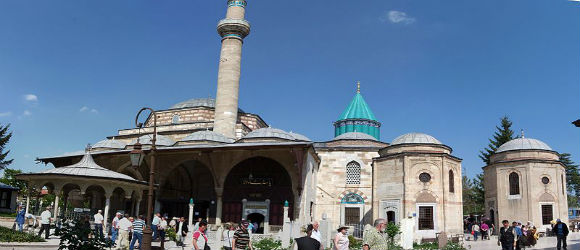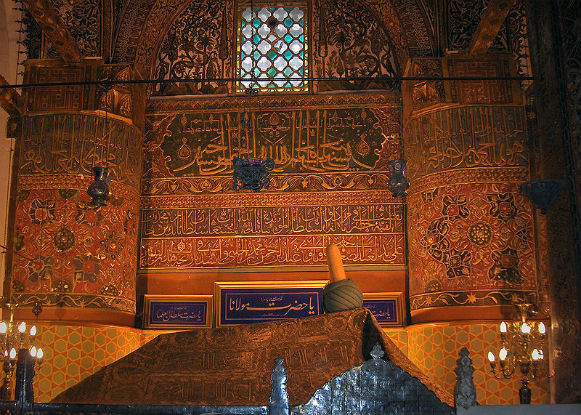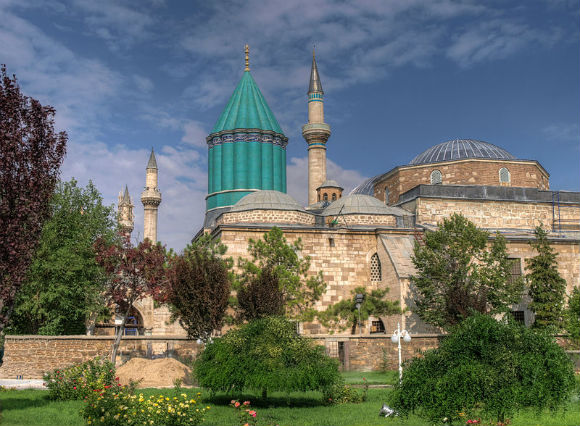The Mevlana Museum also known as the Green Mausoleum or Green Dome, is the original lodge of the Mevlevi Whirling Dervishes, a mystical Sufi Muslim group. It containes the tomb and shrine of the Mevlana, or Rumi, which remains an important place of pilgrimage.
History
Sultan ‘Ala’ al-Din Kayqubad, the Seljuk sultan who had invited Mevlana to Konya, offered his rose garden as a fitting place to bury Baha’ ud-Din Walad (or Bahaeddin Veled), the father of Mevlana, when he died in 1231. When Mevlana himself died on December 17, 1273, he was buried next to his father.
Mevlana’s successor Hüsamettin Çelebi built a mausoleum (Kubbe-i-Hadra) over the grave of his master. The Seljuk construction, under architect Behrettin Tebrizli, was finished in 1274. Gürcü Hatun, the wife of the Seljuk Emir Suleyman Pervane, and Emir Alameddin Kayser funded the construction.
The cylindrical drum of the of the dome originally rested on four pillars. The conical dome is covered with turquoise faience. Several sections were added until 1854. Selim I decorated the interior and performed the woodcarving of the catafalques.
A decree by Ataturk in September 1925 dissolved all Sufi brotherhoods in Turkey. On April 6, 1926, another decree ordered that the Mevlana mausoleum and dervish lodge be turned into a museum. The museum opened on March 2, 1927.
Special permission granted by the Turkish government in 1954 allowed the Mawlawi dervishes of Konya to perform their ritual dances for tourists for two weeks each year. Despite government opposition the order has continued to exist in Turkey as a religious body. The tomb of Rumi, although officially part of a museum, attracts a steady stream of pilgrims.
What to See
The dervish lodge (tekke) includes a semahane, where the ritual sema or whirling ceremony takes place, a sadirvan for ritual ablutions, a library, living and teaching quarters, and the mausoleum housing the tomb of Celaleddin Rumi, founder of the sect and later awarded the honorable title of Mevlana. His epitaph reads: “Do not seek our tombs on this earth – our tombs are in the hearts of the enlightened.”
The mausoleum room is highly ornamented with Islamic script and enameled reliefs, and contains the tombs of several of the more important figures of the dervish order. The main tomb enclosed behind a silver gate crafted in 1597 is that of Mevlana. The tomb of his father, Bahaeddin Veled, is upright and adjacent to his son’s, a position that signifies respect.
The adjoining room, or the semihane, is now a museum of Mevlana memorabilia displaying musical instruments and robes belonging to Mevlana, along with Selçuk and Ottoman objects like gold-engraved Korans from the 13th century. Among the fabulous ancient prayer rugs is the most valuable silk carpet in the world.
Mevlana Museum, Konya,




This place is rather special. It is interesting, welcoming, beautiful and has a reverence about it. You are provided with lots of relevant information and it is very relaxed. It clearly is a place Turkish families like to visit. On Fridays it can get busy. Allow yourself a 2 or 3 hours to see it all.
This is the place where Rumi the founder of the Mevlani Dervishes (and many of his followers ) is buried.
It is a beautiful spiritual place even although its usually packed. You really should not miss it.
No pictures of the inside as they are not allowed but I recommend it.
At the entrance there were one opening marked with universal sign for walkers and wheelchairs. I payed the 3 TL ticket that was wasted money. There are several places where you must lift the walker and for wheelchairs it is impossible. On a Saturday there was such an amount of visitors walking in both directiions the chance to go around…
Pretty interesting to hear about the life of Rumi and Dervish order and you don't need a guide- just pick up an audio guide. Give yourself max 2 hours.
The Sufi museum is worth visiting but try and go early or later in the day when there are fewer visitors. It is important to dress conservatively – knees and arms covered for men and women – as this is a religiously important area.
This Mevlana Museum is the home of the whirling dervishes museum with a real sense of peace, calm, spirituality and love.
Konya is a spiritual city and is the home to one of the greatest theologian ever to have lived called Mevlana in Turkey. This museum is one of the buildings where the Seljuk architecture applied. Inside the museum, there…
Very nice museum. Picked the audio tour and it was very good to understands Rumi and sufism history.
It 's a good place to visit once you pass by konya to learn more about the philosophy of Melvana but it's a little bit crowdy
Unfortunately this time of year is hot and the place is not peaceful and serene – we had to compete with the crowds. The small rooms with the historic artefacts are not pleasant when full of people all trying to take photographs.
The queue through the mausoleum moved slowly. You have to put plastic galoshes over your shoes and women…
Place with atmosphere and information about Mevlyana's time and culture. It's better to come around closing, less crowded.